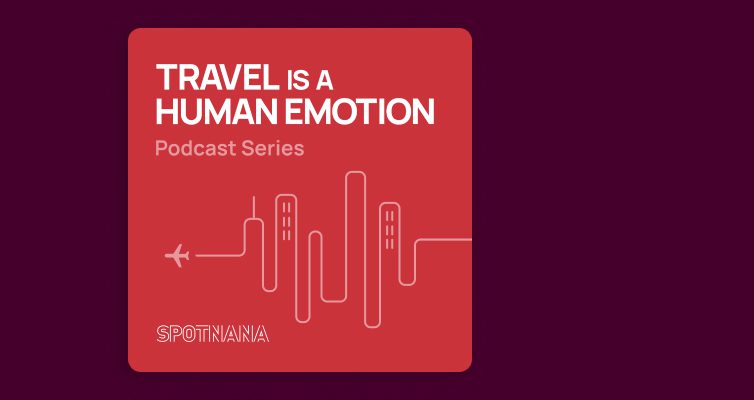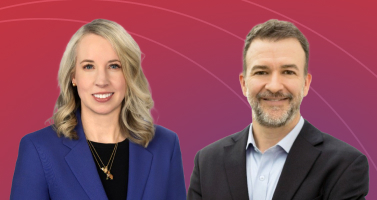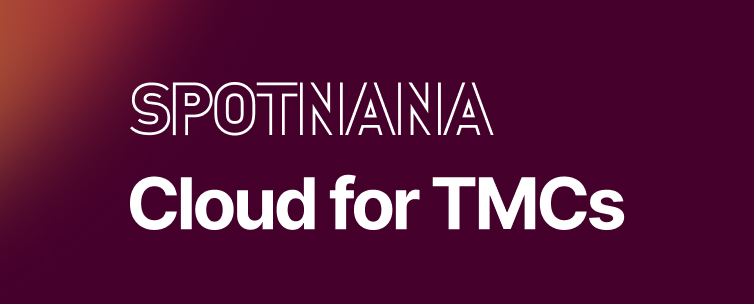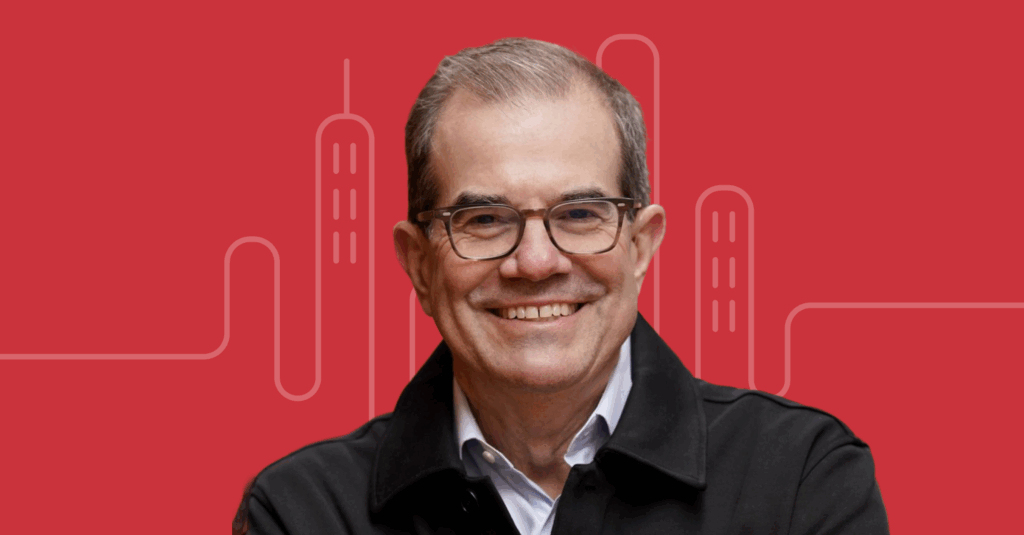Expensify CEO on travel, expense, and AI assistants
Guest: David Barrett, CEO of Expensify
Host: Justin Schuster, VP of Marketing at Spotnana
Length: 26:42
David Barrett joins Justin Schuster to discuss the natural fit of travel and expense, Expensify’s decision to partner with Spotnana on travel, and how a super app user experience is transforming Expensify for its customers.
Justin Schuster: Welcome to the Travel is a Human Emotion podcast. My name is Justin Schuster and I’m the VP of Marketing at Spotnana and I couldn’t be more excited today. My guest is David Barrett, the founder and CEO of Expensify. And David, welcome. I wanted to kick things off by asking you a little bit about the market for expense and spend management software, which is very competitive.
Could you tell me a little bit about how your growth strategy is different from your competitors?
David Barrett: Sure. Hey, thanks for having me here. It’s been a real pleasure. It’s been amazing working with Spotnana. So I’d say, the industry for expense and travel is absolutely huge. And the way that we see it’s largely untapped.
If you were to add up, essentially all of the customers of us and all of our competitors, it adds up to, I don’t know, a few hundred thousand businesses globally, but there’s something like 300 million businesses in the world. So the way that we see it is the sum of the entire industry over decades of effort has added up to about 0.1% of the global opportunity.
Clearly something’s wrong, something is wrong with how everyone else is doing it, if you will. And so our approach is actually quite different in terms of, even though we’re solving a similar, really the same problem, we’re solving it in a very different way with a completely different business model.
I would say everyone else out there has a very traditional kind of top down enterprise sales model where they’ve built a product and brand and marketing machine and sales machine focused on just the needs of. Exclusively the CFO, the travel manager, whoever might that be. Our approach is different.
We think that the boss is outnumbered a hundred to one by their employees, and so we’ve really made it our bread and butter to be the best possible experience for the end user, for the actual travelers themselves. And so again, we need to solve the same problems, especially for the finance team and the management so forth.
But really the way that we solve it is by paying particular attention to the end user experience. And this affects basically every aspect of our design, our branding, and things like this. We did a Super Bowl ad a couple years back where we got 2 Chainz to do an amazing sort of hip hop video.
We’re the top sponsor of the F1 movie coming out basically here in a couple of months. Our whole appeal is really towards the end users. We encourage them to pull us into the organization automatically basically without asking for permission, just using us.
And then they turn around and submit an expense report to their boss using Expensify, turning their expense report into a highly targeted marketing message directly to the decision maker. So again, it’s a completely different technology, brand, and business model. And it’s what got us here. It’s what’s basically put us on the map and that’s what we think is gonna take us over the horizon.
Justin Schuster: Fantastic. In support of that strategy I read that you launched New Expensify, and can you tell us a little bit more about what the difference is between Expensify and the new version, and how that ties into the strategy you just articulated.
David Barrett: Of course. So Expensify has been around for a bit.
We were the very first expense reporting mobile app, which sounds insane. We were the first to offer any kind of integrated receipt scanning, things like this. And so we’ve been around for a while here. And this business model that I mentioned, this kind of bottom up adoption model.
I wouldn’t say it was the initial plan, it’s just what we fell into and what worked incredibly well. And so I would say a few years back as we’re prepping for IPO, we’re like, we’re really just top of our game. Most of our competition was basically just in ruins at our feet, whatever it might be.
And so we felt really good about our position, but also we recognized. We are still pretty small. Sure, maybe we were growing and one of the biggest out there, but relative to the opportunity size, we were just nothing. Everyone was nothing. And so we’re like, okay, if we want to go after this bigger opportunity, we need to lean into what has worked for us and build a design that is designed to capture this difference between the red ocean and the blue ocean.
It’s right now we live in kind of the red sea, these very insanely competitive bloody waters where everyone’s just fighting each other to the death. Whereas there’s this huge blue ocean out there that’s just totally untapped and just ignored by everyone else. And so we decided we wanna go out there and capture that blue ocean.
Look, would it be possible to be an expense management application that has a billion users, a billion people do expenses? It’s totally possible. Instagram got a billion people to talk about photography. Can we get a billion people to talk about money? Maybe. It’s not gonna happen by chance.
It’s gonna happen because you actually set up to try. And so we’ve set about this, pretty bold plan. We’re gonna essentially rewrite the product from scratch around New Expensify. And it’s built to do the same thing, to solve the same problems, but to solve it in the ways that we’ve learned over the course of building Expensify Classic.
There’s just a much more collaborative, more real time and also more AI-centric design out there. And so I think that AI, everyone talks about it constantly, but I would say it’s one thing to layer AI onto an existing traditional application. We’ve tried to really build an application from scratch, built around this idea that every expense is a conversation between an employee and their business and that conversation should be a real-time conversation.
If you weren’t using an expense management tool, you’d be using text or email. You would be doing something that involves talking to people. So we built our entire design in a conversational-first manner, and then we infused AI throughout every layer of it.
And so it’s pretty wild. It’s pretty awesome. It’s very different. And so it’s been a pretty exciting journey so far.
Justin Schuster: As I was learning about New Expensify, I thought it was really interesting that this perspective that every payment is ultimately a conversation in that you can think of accounts payable and invoices and bill pay all as variations on a theme in a similar way.
Can you say a little bit more about that?
David Barrett: My background, I’ve been a programmer since I was six computer graphics and video games where I got started. Then I went into peer-to-peer content distribution. So I have a very weird background as an expense report magnate.
And so I didn’t know anything about this industry, but I think the biggest thing is I knew I didn’t know it. And so as a result I was just making up everything as we went along and the people who knew too much were like, no. Okay. Payroll, invoicing, bill pay, expense management, corporate cards, travel.
These are all completely different industries, wildly different branding, different everything. From my mind, I’m like, they all seem like the same thing. Everything is a variation upon a list of expenses you give to someone and they pay you. Now there’s details, if you give this list of expenses to your boss, it’s called an expense report.
You give it to your client, it’s called an invoice. If someone gives you a list of expenses, it’s called a bill. If it’s basically electronic now, we call it a corporate card. Everything’s kind of the same thing with different flavors of it. And so we set out to build a platform, a truly universal payments platform that could do all of this.
And so as a result, we were the first to really embrace this super app design. Go back a few years, everyone’s basically saying it’s all about, point solutions and integrating with, the best of breed of bunch vendors. I don’t know that, that environment kinda sucks.
It just sucks to have all these to set up your bank account seven different times. It’s to talk to the same exact people. It connected the same accounting system. It’s just a huge waste of time. So we built basically this Universal Payments super app platform. And that was basically, you know what build Expensify Classic.
And I think that over time the rest of the industry has caught up and realized it’s actually really not. No one wants 10 different vendors to do the same thing. They want one vendor that does 10 things. And then I think also looking back and kinda reflecting into what’s worked. I think that we’ve leaned really heavily into automation.
As I mentioned, they’re the very first to do integrated receipt scanning. We introduced this concept of a real-time expense reporting where it’s not just about scanning the receipt, but automating how you put into the report the approvals, automating the approvals, and also the reimbursements and exporting everything.
You should scan a receipt and it just appears in your bank account and accounting package. And we’re the first to do that. We realized you can only really automate like 80% of the flow. And it’s hard. It takes effort and we were hard for that, but there’s like the nagging 20% that really boils down to just the human component.
Like you can automate everything up to the point where you need someone to say yes, and maybe it takes them like a second to actually do it. But if it just sits in their inbox for a week, that means it delays the entire process for a week. We realized the human component, the conversational component is the part that’s actually slowing the entire process down.
And when people say expense reports suck, they don’t be like, oh, it sucks to have a payment appear in my bank account. That part works fine. What sucks is, I hate how at the end of month I’m being nagged by a bunch of people for this thing that I did months ago, and I just don’t care.
I’m over it. But they care a lot and that whole experience sucks. So we’ve basically built our design around. Trying to first streamline the human component by bringing the sort of conversational design into the platform, but then secondarily put us into a position using AI to automate that last 20%.
Because let’s say the last 20% involves information that’s not in the system. If you swipe a credit card, it tells you a lot about the purchase, but it doesn’t tell you who you are actually meeting or what the context around it. All that is somewhere, it’s somewhere in the conversation around there.
And with new LLM technology, you can start to extract real information out of those conversations to do the next level of automation. But you can only do that automation if the conversation is actually in the tool in the first place. And so it’s really about going for a true hundred percent automation vision.
Now it’s an asymptotic approach towards it. We’ll never exactly get there. But I think we can get much closer by unlocking the next generation of data for automation, which is captured in the conversation surrounding the expense.
Justin Schuster: That makes a huge amount of sense. And you have access to a lot of conversations through the very large audience that’s already using Expensify today and growing really rapidly.
I read that you’re driving a lot of innovation with AI. This came through loud and clear in your last earnings call as well. And you had some great projects that you’re outlining. Where are you seeing the most benefit and what are the projects on the horizon that you are most excited about?
David Barrett: Yeah, again, it’s tough talking about AI and not sounding like a lunatic because all this stuff sounds… it’s so easy to roll your eyes and be like, I heard it all before. It’s never happened. But then when it does happen, we’re like, oh wow, okay. I guess that was real. And so I’d say a lot of the stuff about AI we prefer to show rather than tell.
A lot of the functionality and investments we’ve made already have been a lot of backend things. Things just get magically better without drawing a lot of attention to it. Like one thing, Expensify as a public company, you can look up our finances, but we’re a weirdly profitable public company.
And then the only profitable expense reporting company that’s ever existed it’s because we take this attitude of automation outsourcing to an extreme. And this produces a very different company. And so I’d say the first benefits of AI were really more internal cost cutting, improving quality speed, and things like this.
I think it starts to become more surface level. When you move down the deep AIthat’s tucked away internally, the more kind of service-level AI are things like, this term idea is a conversational correction. Imagine for example you scan a receipt and it’s just and it’s for a Subway and it’s seven bucks.
So far the accounting stuff, now is that a sandwich? Is that a train? What might it be? And so it, it shows you a list of, a thousand possible categories of what this might be. Now the first thing is okay, even though those categories might differ by company to company, they’re based upon a human language like it’s clear if it’s Subway it’s either a sandwich or a train.
It’s not a flight, it’s not a variety of things. And so you don’t have to show them a list of a thousand options. You can probably boil it down to two options and then reach out to them basically in a more conversational way and say Hey, I saw you scan this receipt, which one is it for?
And then make it really easy for them to respond. It’s oh, actually that was a train or whatever. And then reaching out to them where they are, such that basically you don’t have to force them to come into the platform and then choose from a giant dropdown or something like this, just text them or email them, and then they can respond very quickly from their phone.
It’s oh, that was a sandwich. And then the automation can kick in and do the rest. Or I think where the AI starts to get really good. Is when it takes off script answers. If it’s okay, I’ve really nailed it down. It’s either a sandwich or it’s train. Which one is it? Is it A or B? And they’re like, oh, actually, sorry.
That was totally a typo. It was supposed to be Safeway. And actually it was for office supplies. And then they have the AI interpret. Oh, okay. Whatever. Actually I’m gonna fix your expenses for you. I’m gonna categorize it based upon the new information you had and add a bit more details to it.
So I think that the next place where audit AI can come in is basically by meeting the customer and the traveler where they are on the road to give them a better experience, if you will. And then as you improve the normalization of data, making it so you can understand the receipts better and things like this, it’s pretty mundane stuff, but it’s hard.
This is the last 20%, all the value of the next generation of expense management’s gonna happen for who can improve your ability to automate the last 20%. And it’s not sexy stuff, but it’s very valuable stuff. Then going beyond that, I think is where you can start to say how do you do more with the data?
Everyone loves to talk about data. Data is valuable and so forth. But I don’t know. I think that knowledge is not power. Action is power, data is only valuable if it actually drives decisions that you can’t make without it. And so people sit in this giant trove of data they can’t really do much with.
Ideally, every company would have this awesome CFO that’s out there doing flux analysis and explaining in real time what’s happening. Most people don’t have that CFO. Most people are just struggling to get through. We want to equip every company with the best possible CFO that’s basically not waiting till the end of the month to do a flux analysis.
It’s basically every single day it’s just Hey, heads up. It looks like there’s a spike in hotel expenses. But then going beyond that and saying actually it’s not a problem because I can see where people are talking about it. It’s actually for this conference here.
And so it looks like it’s gonna be a one time spike. That kind of knowledge is what a human CFO would be able to do. Because they’re tapped into information that goes beyond what’s in the actual ledger system. They’re not just looking at the transactions after they happen. They’re aware of what’s going to happen in the future, and that conversation happens somewhere in chat.
It’s all about trying to crack that last 20% to give the best automation, but then go beyond a hundred percent and say, no, we’re gonna start automating things that you don’t even have the capacity to do. It’s all pretty hand wavy. I understand. And so a lot of this is wait and see and understand that, and that’s fine.
Like we get it. But we’re building it. And so we’re trying to make all this true. And I think that’s our differentiation.
Justin Schuster: I’m a big believer that the more unsexy the problem, the higher the value that there is delivered. And Spotnana is in a similar boat in that we are focusing a lot on fixing the plumbing of the travel industry.
Lots of APIs and integrations, and making it possible to have a great traveler experience and travel shopping experience and a lot of very unsexy but very valuable problems to solve. You recently launched a travel offering that’s powered by Spotnana. What was your vision for how travel and expense should ideally work together?
David Barrett: Sure. It’s called T&E for a reason. I think they go hand in hand and like the business traveler is a huge part of, obviously. Our customer base and our key sort of persona, whatever it might be. Okay, Expensify has been on the sidelines for travel for a very long time.
And I think as I mentioned earlier, for a long time it was a best practice to partner with a million different providers. And that’s what the industry wanted. And also we were just busy, just focusing on expense management. You can only do so many things. So I think that the industry has shifted more towards, as I mentioned, a kind of a single solution, a super app design that’s basically one app.
So I set up my employees once and it works well for everything. When we were basically trying to flesh out our own sort of offering with travel, we’re looking at this it’s just really hard to do. And it’s not just technology because I think travel management and the travel industry in general it’s, as we were talking before it’s not exactly the most high tech industry. A lot of this is pretty old school. It involves a lot of people in terms of people on the phone, people negotiating contracts and deals, people reconciling text files in the backend. It’s a very human-driven process.
We think that Spotnana is the most tech-enabled for this very human-driven process. And so we were basically looking for who is going to support our vision for the best possible end user travel experience. And we think that by far Spotnana is the best partner for that.
Justin Schuster: And why did you decide to partner for this technology rather than build it from scratch?
David Barrett: That’s a good question. I think it’s because we did try to build it from scratch and it wasn’t very good. And so I think that first we’re like, okay, we can do this. How hard is this sort of thing? We’ve got people, we’ve got support, we get all this kind of stuff. And the more we get into it, we’re like, oh, wow.
Okay. That’s a weird case. We didn’t plan on that one. And there’s just so many weird cases. I’m like, okay, this is a much more complicated space. And I think we initially kinda realized, and so fundamentally we always try to do as much as we can in house. But I think we recognized, and this is an area where this is a really complicated space where we’re not experts in it.
And so we just really want to leverage the best expertise and the best technology that’s already out there
Justin Schuster: As I was preparing for today, I learned more about some of the other areas of innovation that you are really a pioneer in. And I learned about the server architecture you have that sounds very differentiated relative to others and how that enables you to be able to provide the offering that you have.
And I also learned about, you’ve evolved a really interesting approach to engineering management and you have an open source development model now that you’ve evolved into and you tap into freelance developers, could you say a little bit more about how that works and how that’s working for you?
David Barrett: Sure. Expensify is an unusual company. And I think that one reason we’re unusual is because we’ve really set out to build a company we never wanna leave, which sounds obvious except that’s just not what anyone else does. Everyone else out there is building a company and from day one, their prime directive is, I wanna sell my company and quit.
And that’s why they’re there, and it’s fine. And it’s a good business model. It works well for investors. It’s a very different environment. And so we see these companies come and go. I don’t know. We’re probably in like generation three or four of competition, if you will. And all of them have gone through that cycle already.
But we’re still here. And we’re still focused on basically building a company that’s gonna last a long time. And a big part of that comes down to profitability. Profitability equals control. You can do whatever you want. And so we’re a very small company. We only have 120 employees or so which is wild.
Justin Schuster: By the way and I don’t know how many other public companies have that level of efficiency that they can point to. I think it’s pretty remarkable.
David Barrett: Yeah. And we’re making over a million dollars per employee. But that doesn’t happen without some radical changes. And so one approach is, again, partnering with companies like Spotnana for best in breed technologies and so forth, building a lot of things in house where we think we have a really decisive innovation.
But also leveraging outsourcing automation to the biggest degree. Most companies view hiring like basketball, and they celebrate basically how many people they have. They’re like, oh my God, I got a thousand people. We view hiring like golf.
You want the fewest possible people because every human is a solution to a problem. Now, ideally, the best solution to a problem is you just solve it and then it’s gone. Don’t need to hire. Next best is that you automate that solution. It’s cool. The next solution after that is that you outsource the problem.
It’s great. I have a series of vendors scattered around the world that can handle this at a very low, efficient cost. Means we don’t need to hire. Hiring is only after you’ve exhausted every alternative. It’s very slow. It’s expensive. It has all these kinds of ramifications. And so hiring is not something that you should celebrate.
Hiring should be something that’s, Ugh, you know what? We have enough problems that require 120 people to fix ’em. If we could do it with less, we would do it with less. And so I think our approach has always been to find the best resource to solve the problem. And when it comes to engineering, there are millions of engineers out there.
And so we decided, okay. Why are we limited to the handful of people that work with us full time when there are truly unlimited numbers of engineers out there that are eager now to tap into that pool? You have to do some things radically. You need to open source. Like you can’t have this approach where, you’re freaked out about people looking at your code because you’re gonna have thousands of engineers going through it. It’s pretty hard to maintain secrecy at that layer and things like this. Plus it’s all fake anyway, like any application that’s on a website, you can just decompile it anyway.
So the idea that people aren’t looking at your source code is a fiction in the first place. And so I think that really came down to recognizing there’s a huge opportunity out there to tap into a global workforce. Just truly, just millions of engineers. We open source our actual prime application.
I think in the world, we’re the only, maybe the only company, like certainly a public company that has their main app is actually an open source app. Lots of companies have APIs that allow others, but like our main thing is open source. As a result, we. We have truly thousands of developers that have contributed to our app.
And it’s completely changed our whole engineering culture where basically it’s okay, now our team of engineers is really just, each one is managing hundreds of other engineers and managing this process that basically churn through a tremendous amount of capacity and does it all from a 120 person company.
Justin Schuster: I’ll wrap things up with the question that we ask all of our guests since this is The Travel is a Human Emotion podcast, when you reflect on that connection between travel and human emotions, what’s most top of mind for you?
David Barrett: My first thing that comes to mind actually is thinking that expense management in general is a weirdly emotional thing, which sounds weird because it’s oh man, no one thinks about expense management. To your point, it’s like it’s one of the most humblest and boring possible things, and yet it is more infuriating than any other tool you have. No one really cares about their payroll tool.
So not like it’s amazing or it’s bad. It’s basically like me, I just get a paycheck, like whatever. There’s no emotion around it. But people hate expense management because expense management is no one’s job, but everyone has to do it. As a result, it’s the kind of thing that takes away from your life.
We find that most of our customers, the number one thing for employees is they say, I love Expensify because it gives me back three hours a weekend to play with my kids. It’s like, how do you put a price tag on that? I guess you can. It’s nine bucks a month. That’s what it costs for us.
But I’d say the main thing is we recognized early on that the people who hated expense management weren’t the CFO. They’re like, that’s fine. I’ve got 50 other players out there that are willing to do whatever I want. The people who hate expense management are the employees because they’re the ones who actually have to deal with it.
Same thing when it comes to travel management. Like these are the people actually on the road there’s no substitute for that. I think that it’s an interesting thing about kind of an AI world and what’s differentiated and what’s gonna last for a long time. And I think that there’s a lot of jobs out there that are really going to be hard to defend.
If you’re working in an office, if you’re working basically just at home, if your job can be done basically from anywhere, that means the job can be done by a robot. But there’s a lot of jobs that can’t be done from anywhere. It’s like there’s no real substitute for sitting down with a customer and looking in the eye.
And so I think that travel is something that is AI proof, because if you are out there traveling, you’re doing something that requires you to be in person or is much better to be in person. And so that’s gonna be true no matter how much the AI is automated. Now, even when I think about the experience of the sort of human emotion experience around travel.
I think that comes down to what is the best possible experience and is it having an app or a website that lets you pull up a giant list of stuff and click through it? Like I doubt it. Like how do you think Jeff Bezos books his travel? Does he do that? I don’t think so. I think he probably just talks to some assistants.
Give some kind of vague guidance, yeah, I need to be in Hawaii vaguely around this time, and then someone else figures it out for him. I think that’s the experience that we’re gonna bring on a massive scale to everyone.
Justin Schuster: Very exciting speaking with you, David. Thank you for being an amazing partner.
Thank you for sharing your time with us and your thoughts with us today and we really appreciate that.
David Barrett: Great. Thanks. It’s a real pleasure.






